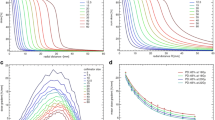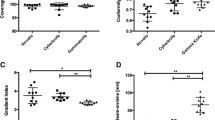Abstract
This study aimed to evaluate the effect of target positioning error (TPE) on radiobiological parameters, such as tumor control probability (TCP) and normal tissue complication probability (NTCP), in stereotactic radiosurgery (SRS) for metastatic brain tumors of different sizes using CyberKnife. The reference SRS plans were created using the circular cone of the CyberKnife for each spherical gross tumor volume (GTV) with diameters (φ) of 5, 7.5, 10, 15, and 20 mm, contoured on computed tomography images of the head phantom. Subsequently, plans involving TPE were created by shifting the beam center by 0.1–2.0 mm in three dimensions relative to the reference plans using the same beam arrangements. Conformity index (CI), generalized equivalent uniform dose (gEUD)-based TCP, and NTCP of estimated brain necrosis were evaluated for each plan. When the gEUD parameter “a” was set to − 10, the CI and TCP for the reference plan at the φ5-mm GTV were 0.90 and 80.8%, respectively. The corresponding values for plans involving TPE of 0.5-mm, 1.0-mm, and 2.0-mm were 0.62 and 77.4%, 0.40 and 62.9%, and 0.12 and 7.2%, respectively. In contrast, the NTCP for all GTVs were the same. The TCP for the plans involving a TPE of 2-mm was 7.2% and 68.8% at the φ5-mm and φ20-mm GTV, respectively. The TPEs corresponding to a TCP reduction rate of 3% at the φ5-mm and φ20-mm GTV were 0.41 and 0.99 mm, respectively. TPE had a significant effect on TCP in SRS for metastatic brain tumors using CyberKnife, particularly for small GTVs.






Similar content being viewed by others
References
Wiggenraad R, Verbeek-de Kanter A, Kal HB, Taphoorn M, Vissers T, Struikmans H. Dose-effect relation in stereotactic radiotherapy for brain metastases. A systematic review. Radiother Oncol. 2011;98(3):292–7.
Aoyama H, Shirato H, Tago M, et al. Stereotactic radiosurgery plus whole-brain radiation therapy vs stereotactic radiosurgery alone for treatment of brain metastases: a randomized controlled trial. JAMA. 2006;295(21):2483–91.
Shaw E, Scott C, Souhami L, et al. Single dose radiosurgical treatment of recurrent previously irradiated primary brain tumors and brain metastases: final report of RTOG protocol 90-05. Int J Radiat Oncol Biol Phys. 2000;47(2):291–8.
Xu Q, Fan J, Grimm J, et al. The dosimetric impact of the prescription isodose line (IDL) on the quality of robotic stereotactic radiosurgery (SRS) plans. Med Phys. 2017;44(12):6159–65.
Treatment Centers. Accuray, Sunnyvale. https://www.accuray.com/treatment-centers/. Accessed 17 Dec 2021.
Kilby W, Dooley JR, Kuduvalli G, Sayeh S, Maurer CR. The CyberKnife® robotic radiosurgery system in 2010. Technol Cancer Res Treat. 2010;9(5):433–52.
Floriano A, Santa-Olalla I, Sanchez-Reyes A. Experience with the CyberKnife for intracranial stereotactic radiosurgery: analysis of dosimetry indices. Med Dosim. 2014;39(1):1–6.
Sio TT, Jang S, Lee SW, Curran B, Pyakuryal AP, Sternick ES. Comparing gamma knife and cyberknife in patients with brain metastases. J Appl Clin Med Phys. 2014;15(1):4095.
Han EY, Wang H, Luo D, Li J, Wang X. Dosimetric comparison of fractionated radiosurgery plans using frameless Gamma Knife ICON and CyberKnife systems with linear accelerator-based radiosurgery plans for multiple large brain metastases. J Neurosurg. 2019;132(5):1473–9.
Zhang S, Yang R, Wang X. Dosimetric quality and delivery efficiency of robotic radiosurgery for brain metastases: comparison with C-arm linear accelerator based plans. J Appl Clin Med Phys. 2019;20(11):104–10.
Zindler JD, Schiffelers J, Lambin P, Hoffmann AL. Improved effectiveness of stereotactic radiosurgery in large brain metastases by individualized isotoxic dose prescription: an in silico study. Strahlenther Onkol. 2018;194(6):560–9.
Wang H, Cooper BT, Schiff P, et al. Dosimetric assessment of tumor control probability in intensity and volumetric modulated radiotherapy plans. Br J Radiol. 2019;92(1094):20180471.
Milano MT, Grimm J, Niemierko A, et al. Single- and multifraction stereotactic radiosurgery dose/volume tolerances of the brain. Int J Radiat Oncol Biol Phys. 2020;3016(20):34101–8 (in press).
ICRU (International Commission on Radiation Units & Measurements). ICRU. Prescribing, recording, and reporting of stereotactic treatments with small photon beams. 2014.
Halvorsen PH, Cirino E, Das IJ, et al. AAPM-RSS medical physics practice guideline 9.a. for SRS-SBRT. J Appl Clin Med Phys. 2017;18(5):10–21.
Dieterich S, Cavedon C, Chuang CF, et al. Report of AAPM TG 135: quality assurance for robotic radiosurgery. Med Phys. 2011;38(6):2914–36.
Guckenberger M, Roesch J, Baier K, Sweeney RA, Flentje M. Dosimetric consequences of translational and rotational errors in frame-less image-guided radiosurgery. Radiat Oncol. 2012;7:63.
Winey B, Bussiere M. Geometric and dosimetric uncertainties in intracranial stereotatctic treatments for multiple nonisocentric lesions. J Appl Clin Med Phys. 2014;15(3):122–32.
Nakano H, Tanabe S, Utsunomiya S, et al. Effect of setup error in the single-isocenter technique on stereotactic radiosurgery for multiple brain metastases. J Appl Clin Med Phys. 2020;21(12):155–65.
Kraft J, van Timmeren JE, Mayinger M, et al. Distance to isocenter is not associated with an increased risk for local failure in LINAC-based single-isocenter SRS or SRT for multiple brain metastases. Radiother Oncol. 2021;159:168–75.
Nakano H, Tanabe S, Sasamoto R, et al. Radiobiological evaluation considering setup error on single-isocenter irradiation in stereotactic radiosurgery. J Appl Clin Med Phys. 2021;22(7):266–75.
Jhaveri J, Chowdhary M, Zhang X, et al. Does size matter? Investigating the optimal planning target volume margin for postoperative stereotactic radiosurgery to resected brain metastases. J Neurol Surg. 2018;130(3):797–803.
Eaton DJ, Lee J, Paddick I. Stereotactic radiosurgery for multiple brain metastases: results of multicenter benchmark planning studies. Pract Radiat Oncol. 2018;8(4):e212–20.
Schlaefer A, Schweikard A. Stepwise multi-criteria optimization for robotic radiosurgery. Med Phys. 2008;35(5):2094–103.
Chang EL, Selek U, Hassenbusch SJ III, et al. Outcome variation among “radioresistant” brain metastases treated with stereotactic radiosurgery. Neurosurgery. 2005;56(5):936–45 (discussion 936).
Paddick I, Lippitz B. A simple dose gradient measurement tool to complement the conformity index. J Neurol Surg. 2006;105(suppl):194–201.
Niemierko A. A generalized concept of equivalent uniform dose (EUD). Med Phys. 1999;26:1100.
Wu Q, Mohan R, Niemierko A, Schmidt-Ullrich R. Optimization of intensity-modulated radiotherapy plans based on the equivalent uniform dose. Int J Radiat Oncol Biol Phys. 2002;52(1):224–35.
Gay HA, Niemierko A. A free program for calculating EUD-based NTCP and TCP in external beam radiotherapy. Phys Med. 2007;23(3–4):115–25.
Chapet O, Thomas E, Kessler ML, Fraass BA, Ten Haken RK. Esophagus sparing with IMRT in lung tumor irradiation: an EUD-based optimization technique. Int J Radiat Oncol Biol Phys. 2005;63(1):179–87.
Chaikh A, Balosso J. The use of TCP based EUD to rank and compare lung radiotherapy plans: in-silico study to evaluate the correlation between TCP with physical quality indices. Transl Lung Cancer Res. 2017;6(3):366–72.
Chaikh A, Docquière N, Bondiau PY, Balosso J. Impact of dose calculation models on radiotherapy outcomes and quality adjusted life years for lung cancer treatment: do we need to measure radiotherapy outcomes to tune the radiobiological parameters of a normal tissue complication probability model? Transl Lung Cancer Res. 2016;5(6):673–80.
Zhao L, Chen M, Ten Haken R, et al. Three-dimensional conformal radiation may deliver considerable dose of incidental nodal irradiation in patients with early stage node-negative non-small cell lung cancer when the tumor is large and centrally located. Radiother Oncol. 2007;82(2):153–9.
Thieke C, Bortfeld T, Niemierko A, Nill S. From physical dose constraints to equivalent uniform dose constraints in inverse radiotherapy planning. Med Phys. 2003;30(9):2332–9.
Horton JK, Halle JS, Chang SX, Sartor CI. Comparison of three concomitant boost techniques for early-stage breast cancer. Int J Radiat Oncol Biol Phys. 2006;64(1):168–75.
Redmond KJ, Gui C, Benedict S, et al. Tumor control probability of radiosurgery and fractionated stereotactic radiosurgery for brain metastases. Int J Radiat Oncol Biol Phys. 2021;110(1):53–67.
Barendsen GW. Dose fractionation, dose rate and iso-effect relationships for normal tissue responses. Int J Radiat Oncol Biol Phys. 1982;8(11):1981–97.
Thames HD Jr, Withers HR, Peters LJ, Fletcher GH. Changes in early and late radiation responses with altered dose fractionation: implications for dose-survival relationships. Int J Radiat Oncol Biol Phys. 1982;8(2):219–26.
Brenner DJ. The linear-quadratic model is an appropriate methodology for determining isoeffective doses at large doses per fraction. Semin Radiat Oncol. 2008;18(4):234–9.
Joiner M. Quantifying cell kill and survival. In: Joiner M, van der Kogel A, editors. Basic clinical radiobiology. London: Hodder Arnold; 2009.
Yuan J, Wang JZ, Lo S, et al. Hypofractionation regimens for stereotactic radiotherapy for large brain tumors. Int J Radiat Oncol Biol Phys. 2008;72(2):390–7.
International Atomic Energy Agency (IAEA). Accuracy Requirements and Uncertainties in Radiotherapy. Human Health Series No. 31. Vienna: International Atomic Energy Agency; 2016.
Allen Li X, Alber M, Deasy JO, et al. The use and QA of biologically related models for treatment planning: short report of the TG-166 of the therapy physics committee of the AAPM. Med Phys. 2012;39(3):1386–409.
Pantelis E, Moutsatsos A, Antypas C, et al. On the total system error of a robotic radiosurgery system: phantom measurements, clinical evaluation and long-term analysis. Phys Med Biol. 2018;63(16): 165015.
Muacevic A, Kufeld M, Wowra B, Kreth FW, Tonn JC. Feasibility, safety, and outcome of frameless image-guided robotic radiosurgery for brain metastases. J Neurooncol. 2010;97(2):267–74.
Dupic G, Brun L, Molnar I, et al. Significant correlation between gross tumor volume (GTV) D98% and local control in multifraction stereotactic radiotherapy (MF-SRT) for unresected brain metastases. Radiother Oncol. 2021;154:260–8.
Dimitriadis A, Kirkby KJ, Nisbet A, Clark CH. Current status of cranial stereotactic radiosurgery in the UK. Br J Radiol. 2016;89(1058):20150452.
Acknowledgements
This study was partially supported by Grants-in-Aid for Scientific Research–KAKENHI (Grant Nos. 19K17227, 20K16819, and 21K07722) from the Japanese Society for the Promotion of Science.
Author information
Authors and Affiliations
Corresponding author
Ethics declarations
Conflict of interest
The authors declare no conflicts of interest.
Ethical approval
This study did not involve any experiments using human participants or animals.
Additional information
Publisher's Note
Springer Nature remains neutral with regard to jurisdictional claims in published maps and institutional affiliations.
About this article
Cite this article
Takizawa, T., Tanabe, S., Nakano, H. et al. The impact of target positioning error and tumor size on radiobiological parameters in robotic stereotactic radiosurgery for metastatic brain tumors. Radiol Phys Technol 15, 135–146 (2022). https://doi.org/10.1007/s12194-022-00655-5
Received:
Revised:
Accepted:
Published:
Issue Date:
DOI: https://doi.org/10.1007/s12194-022-00655-5




